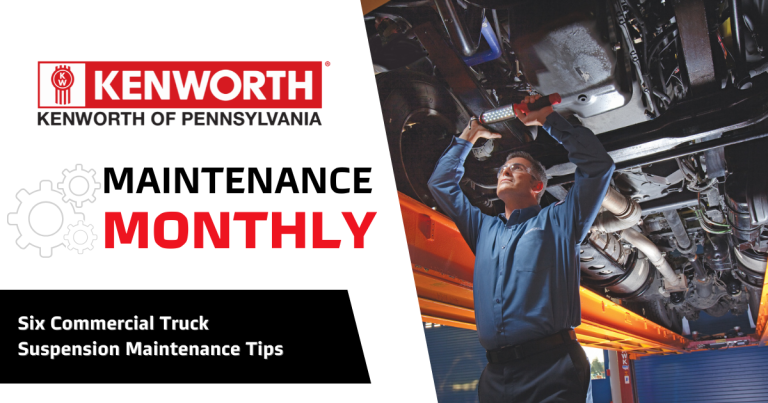
When it comes to commercial truck maintenance, suspension systems are often overlooked, until the ride gets rough or costly repairs show up unexpectedly. A well-maintained suspension system not only ensures a smoother, more comfortable ride, but also helps prevent damage to other critical components like the drivetrain and chassis. Whether you are driving long hauls, local routes, or even managing your fleet, understanding, and maintaining your truck’s suspension system can help save you money and headaches in the long run. In this edition of our Maintenance Monthly, we are going to share six key truck suspension maintenance tips that every commercial vehicle operator should follow.
One of the most important but easily overlooked aspects of suspension health is ride height. The ride height is controlled by the leveling valve, which ensures that the truck remains level regardless of the load weight. If the leveling valve or its linkage is worn or not adjusted properly, it can cause the truck to sit too high or too low.
Why this matters:
Routine inspection of the leveling valve and ride height settings should be part of every scheduled maintenance check.
Air suspension systems rely on air bags to absorb shocks and provide a smooth ride. Like any rubber component, these bags will degrade over time due to temperature changes, road debris, and general wear and tear.
Signs of air bag fatigue include:
Failing to inspect and replace worn air bags can compromise your ride quality and safety. Regular visual inspections and replacing bags at manufacturer-recommended intervals are key to long-term performance.
Suspension bushings play a critical role in absorbing road shock and reducing vibration between the suspension and the truck’s frame. Over time, worn or damaged bushings can lead to a rougher ride, poor alignment, and added strain on other suspension components.
Look out for:
Replacing worn bushings in a timely manner reduces the stress on other components and keeps your truck running smoothly.
Shocks are essential for maintaining ride quality by dampening suspension movement. When they become worn, start leaking, or are damaged, your truck can bounce excessively, sway during turns, and take longer to stop safely.
Be sure to:
Neglecting worn shocks can lead to damaged suspension components, cargo instability, and driver fatigue.
Loose or incorrectly torqued suspension components can lead to unpredictable handling and premature wear. Performing regular torque checks on critical bolts and hardware helps keep everything secure and functioning as it should be.
In addition, maintaining proper wheel alignment is crucial, as misalignment not only accelerates tire wear but puts uneven stress on the suspension, leading to costly repairs.
If your drivers report a rougher ride, strange noises, or changes in how the truck handles, take it seriously. These early warning signs often point to suspension issues. Encouraging clear communication between drivers and maintenance crews is a simple yet effective step to catch problems early before they become costly repairs down the road.
Your truck’s suspension system does much more than simply provide a comfortable ride; it protects vital components, improves safety, and ensures efficient operation. Staying proactive by following key suspension maintenance tips, such as monitoring ride height, replacing worn parts like air bags, bushings, shocks, and addressing issues early, helps keep your fleet operating smoothly and minimizes costly downtime.
Interested in learning more about proper commercial truck suspension maintenance? Contact our trusted service experts at a Kenworth of Pennsylvania store nearest to you.